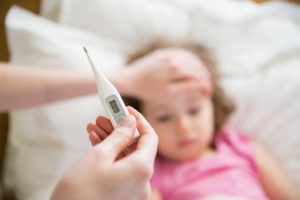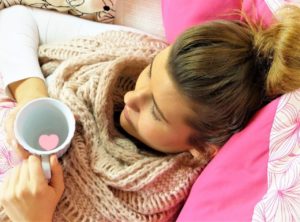You and your child have returned from a trip to the forest. You have discovered a tick and do not know exactly what to look for? We can help you and have the answer to your questions: How do you recognize Lyme disease? How can you treat it? How can you protect your child?
Lyme disease is a bacterial infection transmitted by ticks. The clearest sign of Lyme disease is the wandering redness. It serves as an early sign of detection. If it is observed, it is necessary to seek medical treatment. If you notice a tick on your child, however, it is no reason to panic. Not every transmission also means an infection.
Table of contents
What Is Lyme Disease?
The term Lyme disease is an umbrella term for a group of bacterial diseases. It is triggered by spiral-shaped bacteria – the Borrelia. Carriers of these bacteria are generally blood-sucking insects. In our region, this means that the most common transmission is through a tick. Therefore, it is important to thoroughly check your child for them after playing outdoors.
What Are The Symptoms Of The Disease?
The symptoms of Lyme disease are manifold and vary depending on the stage of spread. Many infections of a Lyme disease are not noticed because no symptoms occur.
In about 90% of cases, the site of the tick’s bite reddens and slowly grows larger. In medicine, this is called migratory redness or erythema migrans. It is an early sign of the disease. It develops between three and thirty days after the bite in the area of the tick bite. However, it can also occur on other parts of the body such as the legs or in the area of the head.
Frequently, migratory redness is accompanied by flu-like symptoms such as fever, aching limbs and headache. In individual cases, but then predominantly in children, skin lesions develop in the form of nodular bluish-red swellings. These often occur on the nipples, ear or genital area.
The most common type of Lyme disease in humans is the Lyme disease. It is also called Lyme disease. The disease can affect different organs. For example, the skin, the joints, or the nervous system.
If the Lyme bacteria spread to the brain or nerves, it is called neuroborreliosis. This happens in about three out of every 100 people who get sick. Symptoms of this type of Lyme disease usually show up a few weeks to months after a tick bite. Possible symptoms include burning nerve pain and paralysis around the face. Children may experience non-purulent meningitis, which may be accompanied by headaches or facial paralysis.
How Is Lyme Disease Diagnosed And Treated?
If you observe redness at the bite site or flu-like symptoms days or weeks after being bitten by a tick, you should take your sweetie to the doctor. A Lyme disease rapid test is not recommended because it does not reliably confirm an infection.
The easiest way to diagnose Lyme disease is through the wandering redness. If this can be observed and you remember the injection site, it can be treated by the doctor with antibiotics. A blood test in the laboratory is then not necessary, because an infection in an early stage can not be detected with this with certainty.
In most cases, early treatment with antibiotics ensures that the patient recovers quickly and completely from Lyme disease. The therapy can prevent more severe courses of the disease. To make sure that the Borrelia bacteria are really completely destroyed, it is necessary to take the antibiotics prescribed by the doctor until the end.
Theoretically, early forms of Lyme disease can be cured without antibiotics Without antibiotics. However, there is a higher risk of severe Secondary diseases. Without treatment, it would be possible for the bacteria to survive in the body for a long time and cause symptoms months or years later.
Depending on the disease and the antibiotics prescribed, a 10- to 30-day treatment can achieve a cure even for late Lyme disease. However, experts advise against longer therapies.
Preventive use of antibiotics after a tick bite is not recommended. Once you have overcome Lyme disease, you are not immune to a new infection. While there is a vaccine for the prevention of early summer meningoencephalitis, this is not the case with Lyme disease.
How Can You Protect Your Child?
Now the question remains, how can you best protect your family and yourself from Lyme disease? The safest way is to avoid tick bites completely. Therefore, it is best to wear closed shoes and long pants and shirts during walks and adventures in the woods and meadows, if the temperatures allow it. Light-colored clothing is also useful because crawling ticks are best seen on it.
Tick repellents are another possibility for prevention Prevention. However, it is important to follow the manufacturer’s instructions. In addition, the effect is limited to a certain period of time and no agent can guarantee guarantee complete protection.
Prevention is of course good and important. Nevertheless, you should carefully check your child’s body and of course your own for ticks after every trip into nature. Ticks especially like to settle on warm and soft regions of the skin. Therefore, you should pay special attention to the back of the knees, the groin, under the armpits, on the ears, on the head, and in the hair area.
Should you discover a tick, it is no reason to panic. Up to one third of the ticks found in Germany carry Borrelia bacteria. But not every bite of an infested tick causes an infection.
It is important that the tick is discovered and removed as early as possible removed as early as possible. The longer a tick sucks, the greater the risk of transmission of transmission. The risk of infection increases after about 12 hours Hours. In Germany, only one bite out of 100 leads to Lyme disease developing. Infected persons are not contagious.
The best way to remove the tick is with tweezers or a special tool Tweezers or a special tool such as tick forceps or a tick card. If no tool is available, it is still best to remove the tick as soon as possible as quickly as possible. Then, for example, fingernails can be can be used. It is important to grasp the tick on the surface of the skin and on its mouthparts Mouthparts. Not fully soaked body! It is best to slowly and as straight as possible from the skin.
Of course, Lyme disease can be a serious threat to your child’s health. But the consequence should not be that you become afraid to let your child discover the world in nature. Appropriate clothing, careful searching for ticks after adventures in meadows and forests, and, in case of doubt, an early visit to the doctor are a good combination to make adventures possible in the future.
FAQ About Lyme Disease
Sources
Amelung, C. R. (2009). Small ticks – big complaints! Lyme disease in rural physician practice: experiences, case studies, perspectives. Amelung Publishers.
https://www.infektionsschutz.de/erregersteckbriefe/borreliose.html










